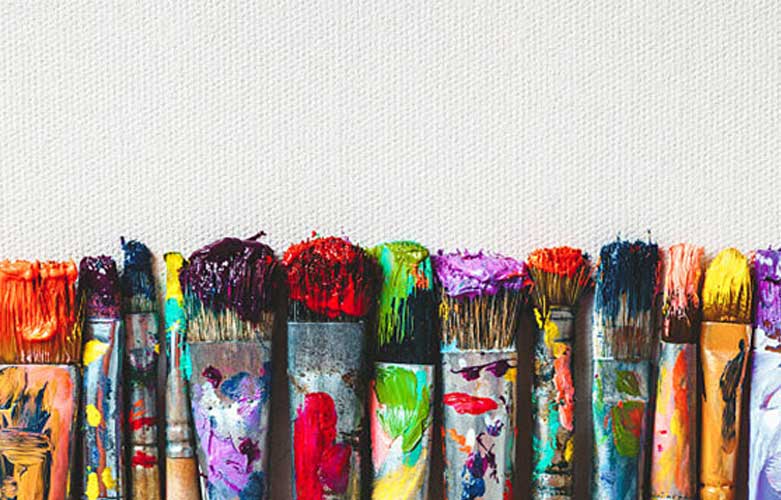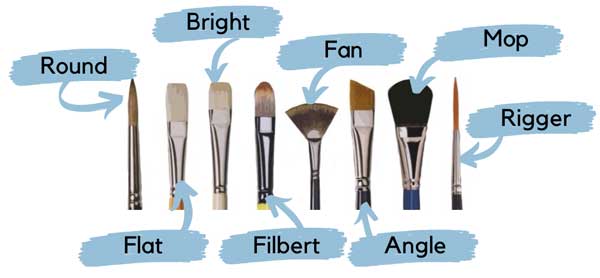
LET’S TALK BRUSHES
Welcome once again to Emily McCormack-Artist’s blog on all things Oil Painting.
I think this week, we have officially entered Spring, as the crocuses and daffodils have erupted here in the Studio gardens, the days are getting longer and the bees have finally ventured out, which is great, as every other Beekeeper I know their bees were out long before Valentine’s Day while not a sign of mine, not even a dickey bee. I have spent much of this month silently mourning their loss and deeming that I was a failed beekeeper. But today, much to my delight they resurrected themselves from the dead and all is well again here in the garden.
So let’s talk brushes, the next essential tool in the Artists painting kit.
Well, where does one start…for the beginner artist it can be incredibly daunting.
Do you go for rounds, flats, brights, filberts, long handle, short handle, natural or synthetic fibre, do you need a fan brush which every beginner’s kit seems to include and how many brushes do you need? Never mind asking yourself just what exactly is a flat, a bright or a filbert?
Brushes – The Introduction
Size
Brushes generally go from a size 00 up to a size 24 and you will usually see the number imprinted midway down on the brush handle. A guide for the numbers is the fatter or wider the bristles and the metal part known as the ferrule the higher the number will be – so a 24 is your widest and 00 is your thinnest or smallest sized brush.
Handle
Brushes can also come with a long or a short handle.
I generally go for long-handled brushes as I like the feel of them in my hand, they allow me to stand back from the painting when I do the initial sketch and to make longer marks as the painting develops.
However, I know many an artist who prefer to use short-handled brushes, especially, those who like working at close range to the painting and doing fine detail, or those who paint out-side (Plein Air Painters) as they are easier to transport and fit nicely into the small compartments in their painting bags.
Bristle
The bristles of the brush, which we paint with can be natural or synthetic.
Natural bristles– basically they come from an animal (i.e. hog (pig), squirrel, goat etc) whereas synthetic bristles are artificial/man-made.
I use both, but I usually tend to go for natural bristle. Until I sat down to write this blog, I never actually questioned, why I go for natural and when you write the word hog or squirrel you think “You poor little dote” and you berate yourself for buying them – so I have a bit of work ahead of me to see just exactly how these brushes are made but at the moment the truthful answer is that I bought them purely out of habit and it was just the done thing to do.
But then one asks – synthetic, how are these produced? And do they effect the environment- that again, I have no idea – which is not a great start to these blogs, now is it? However, I do know that synthetics have evolved over the years and they tend not to wear or lose their shape as quickly as natural.
Shape

So a Round, just has a pointed tip and is good for doing detail, a Flat is basically the same as a Bright it has a flat head but the bristles are longer than a bright’s. You can also have a long or a short bristled Flat. Both are good all-rounders. I particularly like using them for landscapes, cutting in and around figures/objects or using the side for line marking.
Filberts just have a curved head shaped like a fingernail. These are my “go to’s” and for many years I only ever painted with a size 4 or 6 filbert, a pallet knife and a roll of kitchen towel. Its only since, we entered lockdown that I started using different / softer brushes as I have the time to experiment more with blending and glazing techniques.
The famous Fan brush every beginner seems to buy and is dying to use – is really only for light blending / soft strokes as its often not strong enough to do much else. The Angle I haven’t used but as the filberts wear they often form an angle so they are good for line marking etc – I haven’t seen many artists use them except floral painters. Finally, the Rigger is good for rendering fine long lines such as ship rigging, telephone lines or branches.
House Brushes or wide flat brushes are also helpful for the initial toning, blocking in or covering your canvas/boards very quickly with washes – which we will look at again in future blogs…
Brushes – Starting Off
Here at Emily McCormack’s Art Studio Workshops, I recommend that beginner students purchase their oil painting brushes as follows:-
- Size 1 or 2 Round,
- Size 4 or 5 Filbert,
- Size 10 or 12 Flat.
With these brushes, there is pretty much nothing you cannot paint and each gives you a different mark. Also, when starting off, a limited number of brushes gives the student time to learn to use each of them. The only reason I give 2 sizes for each is that sometimes art shops might only have one or the other in stock at the time of purchase.
The brand of brush I specify, as they are cheap, cheerful and made in Ireland and are not a bad brush are those by Richard Oliver and you can get these from K&M Evans (who are based in Dublin). I use these myself, as I go through brushes very quickly here in the studio. Other brands, include Winsor & Newton and Daler Rowney and I really love using Da Vinci which you can get from Kennedys Art Store also in Dublin and Rosemary & Co which you can get from Spectrum in Wexford town or Rosemary’s & Co’s own website.
Next on my list to try are Grumbacher’s Degas filberts and Silver Brush – Grand Prix Filberts so I’ll let you know how I get on.
Next week we will talk palettes…
Emily McCormack
February 2021
Become an insider, subscribe to receive
Stunning previews of new art, discounts, painting tips and early booking for painting workshops.



